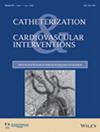Transcatheter aortic valve implantation for severe aortic regurgitation using the J-Valve system: A midterm follow-up study
Abstract
Background
Transcatheter aortic valve implantation (TAVI) is a well-established intervention for severe aortic valve stenosis. However, its application for severe aortic regurgitation (AR) is still under evaluation. This study aims to present the 3-year follow-up outcomes of the J-Valve system in managing severe AR.
Aims
The aim of this study was to evaluate the mid-term efficacy and durability of the J-Valve system in the treatment of severe AR and to provide new information on this intervention.
Methods
In this retrospective, single-center study, we evaluated the prognostic outcomes of patients with AR, who underwent treatment with the J-Valve system at Nanjing Drum Tower Hospital. Consecutive patients who were treated with the J-Valve were included in the analysis. The study focused on the echocardiographic follow-up to assess the effectiveness and durability of the J-Valve system in managing AR.
Results
From January 2018 to December 2022, 36 high-risk AR patients treated with the J-Valve system had a procedural success rate of 97.2%, with one case requiring open-heart surgery due to valve displacement. Significant improvements were observed in left ventricular diameter (from 63.50 [58.75–69.50] mm to 56.50 [53.00–60.50] mm, p < 0.001) and left atrial diameter (from 44.00 [40.00–45.25] mm to 39.00 [36.75–41.00] mm, p = 0.003) postsurgery. All patients completed the 1-year follow-up, with an overall mortality rate of 2 out of 36 (5.6%). Among the surviving patients, there was one case of III° atrioventricular block and one case of stroke, both occurring within 90 days postsurgery. After a 3-year follow-up, 15.0% of patients had mild or moderate valvular regurgitation, with no cases of moderate or severe paravalvular leak. Additionally, 89.5% of patients were classified as New York Heart Association class I or II, showing significantly enhanced cardiac function.
Conclusion
The J-Valve system has shown positive therapeutic outcomes in treating AR, with notable effectiveness in managing the condition and significant improvements in heart failure symptoms and cardiac remodeling. However, due to the limited sample size and partial follow-up data, it is important to emphasize the need for further research with comprehensive long-term follow-up, to fully validate these results.

 求助内容:
求助内容: 应助结果提醒方式:
应助结果提醒方式:


